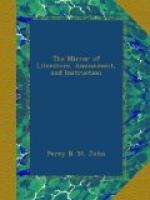“Their wooden repositories for the dead are what are in the most perfect state of preservation. These are of different constructions, it would appear, according to the character or rank of the persons entombed. In one of them, which resembled a hut ten feet by eight or nine, and four or five feet high in the centre, floored with squared poles, the roof covered with rinds of trees, and in every way well secured against the weather inside, and the intrusion of wild beasts, there were two grown persons laid out at full length, on the floor, the bodies wrapped round with deerskins. One of these bodies appeared to have been placed here not longer ago than five or six years. We thought there were children laid in here also. On first opening this building, by removing the posts which formed the ends, our curiosity was raised to the highest pitch; but what added to our surprise, was the discovery of a white deal coffin, containing a skeleton neatly shrouded in white muslin. After a long pause of conjecture how such a thing existed here, the idea of Mary March occurred to one of the party, and the whole mystery was at once explained.[3]”
[3] It should be remarked
here, that Mary March, so called from the
name
of the month in which she was taken, was the Red Indian
female
who was captured and carried away by force from this
place
by an armed party of English people, nine or ten in
number,
who came up here in the month of March, 1809.
The local
government
authorities at that time did not foresee the result
of
offering a reward to bring a Red Indian to them.
Her
husband
was cruelly shot, after nobly making several attempts,
single-handed,
to rescue her from the captors, in defiance of
their
fire-arms, and fixed bayonets. His tribe built
this
cemetery
for him, on the foundation of his own wigwam, and his
body
is one of those now in it. The following winter,
Captain
Buchan
was sent to the River Exploits, by order of the local
government
of Newfoundland, to take back this woman to the lake,
where
she was captured, and if possible at the same time,
to
open
a friendly intercourse with her tribe. But she
died on
board
Captain B.’s vessel, at the mouth of the river.




